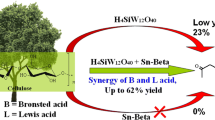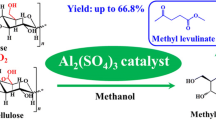Abstract
Acid catalytic hydrolysis of cellulose to levulinic acid (LA) was conducted by partly replacing homogeneous catalyst sulfuric acid (H2SO4) with solid acid Nafion® NR50. With the presence of Nafion® NR50, 75% of H2SO4 catalyst can be saved, and a high LA yield, 40.4 wt%, was realized even without stirring the reaction solution. Although stirring favored the LA yield and shortened the reaction time, the deactivation of Nafion® NR50 was observed. In fact, non-stirring condition is advocated, under which the Nafion® NR50 still maintains excellent catalytic activity and reusability.








Similar content being viewed by others
References
Kang S, Fu J, Zhang G (2018) From lignocellulosic biomass to levulinic acid: a review on acid-catalyzed hydrolysis. Renew Sust Energ Rev 94:340–362
Pileidis FD, Titirici MM (2016) Levulinic acid biorefineries: new challenges for efficient utilization of biomass. ChemSusChem 47:562–582
Morone A, Apte M, Pandey RA (2015) Levulinic acid production from renewable waste resources: bottlenecks, potential remedies, advancements and applications. Renew Sust Energ Rev 51:548–565
Isoni V, Kumbang D, Sharratt PN, Khoo HH (2018) Biomass to levulinic acid: a techno-economic analysis and sustainability of biorefinery processes in Southeast Asia. J Environ Manag 214:267–275
Antonetti C, Licursi D, Fulignati S, Valentini G, Galletti AMR (2016) New frontiers in the catalytic synthesis of levulinic acid: from sugars to raw and waste biomass as starting feedstock. Catalysts 6:196
Bozell JJ (2010) Connecting biomass and petroleum processing with a chemical bridge. Science 329:522–523
Lange JP, Price R, Ayoub PM, Louis J, Petrus L, Clarke L, Gosselink H (2010) Valeric biofuels: a platform of cellulosic transportation fuels. Angew Chem Int Ed Eng 122:4581–4585
Freitas FA, Licursi D, Lachter ER, Raspolli-Galletti AM, Antonetti C, Brito TC, Nascimento RSV (2016) Heterogeneous catalysis for the ketalisation of ethyl levulinate with 1,2-dodecanediol: opening the way to a new class of bio-degradable surfactants. Catal Commun 73:84–87
Rivas S, Galletti AMR, Antonetti C, Licursi D, Santos V, Parajó JC (2018) A biorefinery cascade conversion of hemicellulose-free eucalyptus globulus wood: production of concentrated levulinic acid solutions for γ-valerolactone sustainable preparation. Catalysts 8:169–184
Domenico L, Claudia A, Sara F, Giannoni M, Galletti AMR (2018) Cascade strategy for the tunable catalytic valorization of levulinic acid and γ-valerolactone to 2-methyltetrahydrofuran and alcohols. Catalysts 8:277–292
Pan T, Deng J, Xu Q, Xu Y, Guo QX, Fu Y (2013) Catalytic conversion of biomass-derived levulinic acid to valerate esters as oxygenated fuels using supported ruthenium catalysts. Green Chem 15:2967–2974
Rivas S, Raspolli-Galletti AM, Antonetti C, Santos V, Parajó JC (2018) Sustainable conversion of Pinus pinaster wood into biofuel precursors: a biorefinery approach. Fuel 164:51–58
Rivas S, Raspolli-Galletti AM, Antonetti C, Santos V, Parajó JC (2015) Sustainable production of levulinic acid from the cellulosic fraction of Pinus pinaster wood: operation in aqueous media under microwave irradiation. J Wood Chem Tech 35:315–324
Licursi D, Antonetti C, Martinelli M, Ribechini E, Zanaboni M, Galletti AMR (2016) Monitoring/characterization of stickies contaminants coming from a papermaking plant-toward an innovative exploitation of the screen rejects to levulinic acid. Waste Manag 49:469–482
Kang S, Yu J (2015) Effect of methanol on formation of levulinates from cellulosic biomass. Ind Eng Chem Res 54:11552–11559
Kang S, Zhang G, Yang X, Yin H, Fu X, Liao J, Tu J, Huang X, Qin FGF, Xu Y (2017) Effects of p-toluenesulfonic acid in the conversion of glucose for levulinic acid and sulfonated carbon production. Energy Fuel 31:2847–2854
Rinaldi R, Schüth F (2010) Acid hydrolysis of cellulose as the entry point into biorefinery schemes. ChemSusChem 3:1096–1107
Vyver SVD, Thomas J, Geboers J, Keyzer S, Smet M, Dehaen W, Jacobs PA, Sels BF (2011) Catalytic production of levulinic acid from cellulose and other biomass-derived carbohydrates with sulfonated hyperbranched poly(arylene oxindole)s. Energy Environ Sci 4:3601–3610
Girisuta B, Janssen LPBM, Heeres HJ (2007) Kinetic study on the acid-catalyzed hydrolysis of cellulose to levulinic acid. Ind Eng Chem Res 46:1696–1708
Kang S, Pan J, Gu G, Wang C, Wang Z, Tan J, Liu G (2018) Sequential production of levulinic acid and porous carbon material from cellulose. Materials 11:1408–1423
Kang S, Yu J (2018) Maintenance of a highly active solid acid catalyst in sugar beet molasses for levulinic acid production. Sugar Tech 20:182–193
Son J, Wilson J (2012) Mesoporous niobium phosphate: an excellent solid acid for the dehydration of fructose to 5-hydroxymethylfurfural in water. Catal Sci Tech 2:2485–2491
Ramli NAS, Amin NAS (2015) Fe/HY zeolite as an effective catalyst for levulinic acid production from glucose: characterization and catalytic performance. Appl Catal B Environ 163:487–498
Shen J, Wyman CE (2011) Hydrochloric acid-catalyzed levulinic acid formation from cellulose: data and kinetic model to maximize yields. AICHE J 58:236–246
Le Guenic S, Gergela D, Ceballos C, Delbecq F, Len C (2016) Furfural production from d-xylose and xylan by using stable NafionNR50 and NaCl in a microwave-assisted biphasic reaction. Molecules 21:1102–1113
Kang S, Li X, Fan J, Chang J (2012) Characterization of hydrochars produced by hydrothermal carbonization of lignin, cellulose, D-xylose, and wood meal. Ind Eng Chem Res 51:9023–9031
Siesler HW, Ozaki Y, Kawata S, Heise HM (2008) Near-infrared spectroscopy: principles, instruments, applications. John Wiley & Sons, Hoboken
Kang S, Lai W, Yin X, Peng Z, Tu J, Huang S (2018) Sequential production of xylose, levulinic acid and activated carbon from pine wood. Chemistryselect 3:9819–9825
Kang S, Jiang S, Peng Z, Lu Y, Guo J, Li J, Zeng W, Lin X (2018) Valorization of humins by phosphoric acid activation for activated carbon production. Biomass Conver Bioref 8:889–897
Kang S, Fu J, Deng Z, Jiang S, Zhong G, Xu Y, Guo J, Zhou J (2018) Valorization of biomass hydrolysis waste: activated carbon from humins as exceptional sorbent for wastewater treatment. Sustainability 10:1795–1814
Son PA, Nishimura S, Ebitani K (2012) Synthesis of levulinic acid from fructose using Amberlyst-15 as a solid acid catalyst. React Kinet Mech Cat 106:185–192
Shen F, Smith RL Jr, Li L, Yan L, Qi X (2017) Eco-friendly method for efficient conversion of cellulose into levulinic acid in pure water with cellulase-mimetic solid acid catalyst. ACS Sustain Chem Eng 5:2421–2427
Girisuta B, Janssen LPBM, Heeres HJ (2006) Green chemicals: a kinetic study on the conversion of glucose to levulinic acid. Chem Eng Res Des 84:339–349
Ding D, Wang J, Xi J, Liu X, Lu G, Wang Y (2014) High-yield production of levulinic acid from cellulose and its upgrading to γ-valerolactone. Green Chem 16:685–693
Joshi SS, Zodge AD, Pandare KV, Kulkarni BD (2014) Efficient conversion of cellulose to levulinic acid by hydrothermal treatment using zirconium dioxide as a recyclable solid acid catalyst. Ind Eng Chem Res 53:18796–18805
Girisuta B, Janssen LPBM, Heeres HJ (2007) Kinetic study on the acid-catalyzed hydro-lysis of cellulose to levulinic acid. Ind Eng Chem Res 46:1696–1708
Liu W, Hou Y, Wu W, Liu Z, Liu Q, Tian S, Marsh KN (2012) Efficient conversion of cellulose to glucose, levulinic acid, and other products in hot water using SO2 as a recoverable catalyst. Ind Eng Chem Res 51:15503–15508
Dussan K, Girisuta B, Haverty D, Leahy JJ, Hayes MHB (2013) Kinetics of levulinic acid and furfural production from Miscanthus × giganteus. Bioresour Technol 149:216–224
Yan L, Greenwood A, Hossain A, Yang B (2014) A comprehensive mechanistic kinetic model for dilute acid hydrolysis of switchgrass cellulose to glucose, 5-HMF and levulinic acid. RSC Adv 4:23492–23504
Adamson MJ (1980) Thermal expansion and swelling of cured epoxy resin used in graphite/epoxy composite materials. J Mater Sci 15:1736–1745
Nandi S, Winter HH (2004) Swelling behavior of partially cross-linked polymers: a ternary system. Macromolecules 38:4447–4455
Funding
This work was supported by the funding of the Engineering Research Center of None-food Biomass Efficient Pyrolysis and Utilization Technology of Guangdong Higher Education Institutes (2016GCZX009), the National Natural Science Foundations of China (21606045, 51476036), the Natural Science Foundation of Guangdong Province of China (2017 A030313084), the Guangdong Innovation Research Team for Higher Education (2017KCXTD030), and the High-level Talents Project of Dongguan University of Technology (KCYKYQD2017017).
Author information
Authors and Affiliations
Corresponding author
Additional information
Publisher’s note
Springer Nature remains neutral with regard to jurisdictional claims in published maps and institutional affiliations.
Rights and permissions
About this article
Cite this article
Xu, Y., Liu, G., Fu, J. et al. Catalytic hydrolysis of cellulose to levulinic acid by partly replacing sulfuric acid with Nafion® NR50 catalyst. Biomass Conv. Bioref. 9, 609–616 (2019). https://doi.org/10.1007/s13399-019-00373-w
Received:
Revised:
Accepted:
Published:
Issue Date:
DOI: https://doi.org/10.1007/s13399-019-00373-w




